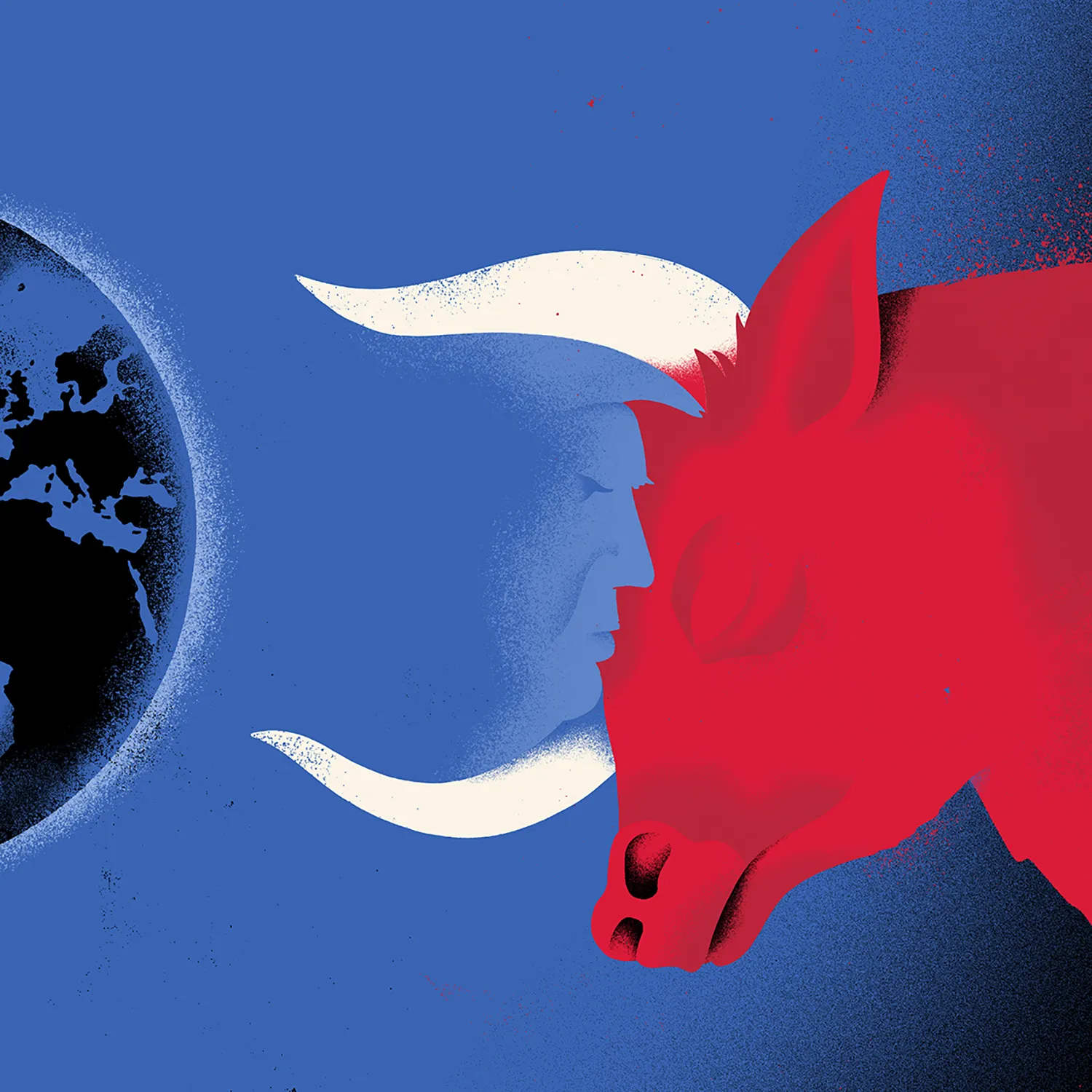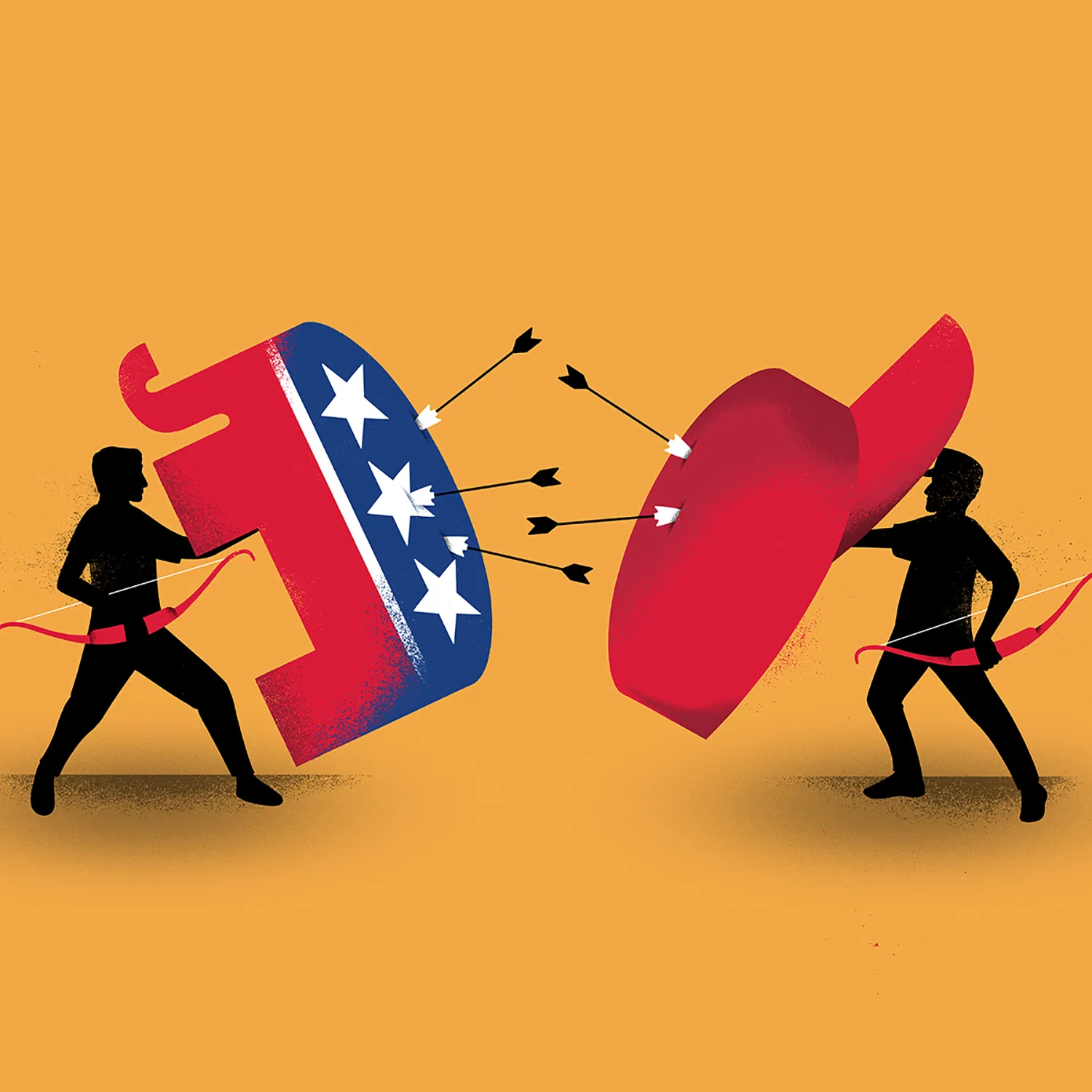Vladimir Lenin once noted that there are decades where nothing happens, and weeks where decades happen. By that standard, the first hundred days of Donald Trump’s presidency have comprised at least 20 years of foreign-policy change.
The administration’s “move fast and break things” approach to foreign policy has been consistent only in its chaos. There have been rapid shifts in America’s approach to high-profile global conflicts: pivoting to negotiations with Russia, promoting a cease-fire in Gaza, and oscillating between threats of military action against Iran and offers of a newly negotiated nuclear deal.
The U.S. Agency for International Development (USAID), meanwhile, was shuttered so suddenly that warehouses full of food aid were left to rot. There have been boundary-pushing immigration moves, including the outsourcing of immigration detention to the government of El Salvador. And then there’s the turmoil inflicted on financial markets by the uncertainty of the administration’s trade policy, involving tariffs turned on and off like a light switch at the president’s whims.
So how are we to make sense of the chaos? It’s clear that the second Trump administration is aiming for change—not inertia—in U.S. foreign policy, though the direction of that change is unclear. Still, there are four explanatory models worth considering as we try to explain its choices so far.
Model No. 1: The Return of Realpolitik

The first model we might apply to understanding Trump’s foreign policy is also perhaps the most coherent: the idea that the Trump administration is pursuing a hard-nosed return to realpolitik, prioritizing China and the Western Hemisphere over Europe and the Middle East. In this context, the administration’s troubled relationship with European allies would be seen as part of a Nixonian attempt to rebalance U.S. strategic commitments after a period of overreach. Indeed, in this view, the Trump administration is not abandoning American leadership of a rules-based international system; it is instead merely acknowledging existing hypocrisy, admitting that U.S. interests will always matter more than vague, liberal ideals like democracy or human rights.
The administration’s approach to Europe is perhaps the best evidence for this model of Trump’s decision-making. Putting pressure on allies to spend more on defense and attempting to extricate the United States from the war in Ukraine through a negotiated settlement with Russia are both policies that have long been favored by realists. There are other pieces of evidence for the realpolitik model of Trump, too. His willingness to use the tools of statecraft as leverage against both adversaries and allies reflects a transactional approach to the world. Using the threat of tariffs to coerce Canada, Mexico, or the European Union on policy issues may be problematic over the long term but could yield quick wins today.
Even the administration’s sudden apparent concern for the Western Hemisphere fits within this model. Secretary of State Marco Rubio’s swing through Latin America shortly after the inauguration, the administration’s concerns about Chinese presence in and around the Panama Canal, and even the seemingly bizarre notion of annexing Greenland all have hard-power rationales behind them, while a number of Trump’s key appointees, including his vice president, clearly hold a realist view of the world.
This realpolitik model, however, falters in other areas. It cannot explain Israel policy. Nor can it easily explain the gutting of foreign-policy agencies. The administration has largely been indifferent to pleas that the destruction of Voice of America or USAID would offer a vacuum to be filled by Russia or China, even though one might assume an administration focused on great-power competition would not seek to undermine the foundations of U.S. soft power. Likewise, tariff policy is challenging to fit in this frame: One could make a realpolitik case for decoupling from China, but not for sanctioning America’s neighbors or dethroning the dollar as the world’s reserve currency.
Model No. 2: Domestic Politics as Foreign Policy

A second model that might explain the Trump administration’s foreign policy is the one so often heard on Democratic-leaning cable media: that foreign policy is driven primarily by domestic agendas—or that it aims to make the rich richer. Sen. Bernie Sanders, for example, described the killing of USAID as “Elon Musk, the richest guy in the world … going after USAID, which feeds the poorest people in the world.”
Certainly, one could interpret the actions of the Department of Government Efficiency (DOGE), and the animus the new administration clearly feels toward the federal bureaucracy, as a continuation of long-running Republican attempts to—as Grover Norquist so memorably put it—shrink the government until one can drown it in a bathtub. The administration has dismantled some federal agencies (e.g., USAID and the Department of Education), while protecting others (e.g., the Department of Defense, the Social Security Administration). The targeted agencies have, by and large, been those least popular with Republican voters and donors.
At the same time, the Trump administration’s foreign economic policy now worries Wall Street and the business community so much that markets are effectively in free fall. There’s significant uncertainty about what tariffs are intended to achieve. Are they leverage for better trade deals with Asia, or concessions on migration or drug policy with Mexico and Canada? Or are they a broad strategy to weaken the dollar and bolster domestic reindustrialization? In one memorable sound bite, Treasury Secretary Scott Bessent told bankers in New York that the essence of the American dream is not merely “cheap goods” from China, a sentiment that was not comforting to America’s economic elites.
Domestic political concerns are reflected elsewhere, too. The speech given by Vice President J.D. Vance in February at the Munich Security Conference was notable not just for its sections on the U.S. commitment to NATO, but also for its emphasis on migration, culture, and his arguments that Europe and the U.S. are diverging in terms of values. Vance’s unorthodox choice to meet with the far-right Alternative for Germany party shortly before the German election also reflects the administration’s appreciation for right-wing parties across Europe.
The domestic politics lens, however, can only take us so far in understanding the Trump administration’s foreign-policy choices. It cannot easily explain the administration’s continued focus on the Middle East, nor in particular, its willingness to give Israel carte blanche. Indeed, the ongoing immigration crackdown on Mahmoud Khalil and other pro-Palestine protesters suggests an inverted relationship between foreign and domestic policy: a preference for Israel in its conflict in Gaza driving a free speech crackdown here at home. Nor can the domestic lens explain the administration’s apparent desire to pull back from Ukraine.
Model No. 3: A Return to the First Term

A third model that might explain Trump’s foreign policy requires us to look back at his first term. Indeed, this has been the conventional wisdom among congressional Republicans, along with D.C.-based diplomats, who argue that—much like the first Trump administration, from 2016 to 2020—the chaos of the early months will soon give way to a mostly conventional Republican administration. Such an administration might have elements of Trump’s unique flair but would broadly continue Republican foreign-policy priorities running back into the George W. Bush administration emphasizing sovereignty, unilateralism, and hawkish military power.
After all, Trump’s first National Security Strategy was relatively conventional; his staff were mainly D.C. apparatchiks. Trump’s summits with North Korean dictator Kim Jong Un and penchant for foreign policy by tweet certainly made for an exciting ride, but foreign policy writ large did not diverge notably from the status quo. Some have even argued that this administration is simply moving toward a kind of “Trump-Reagan” synthesis that brings the party slightly more in line with Trump’s own preferences while keeping most of its traditional Reaganite foreign-policy orientation.
Many of the more radical departures from Republican orthodoxy in the first hundred days can be accommodated in this model simply by blaming them on Trump’s personality. Overtures to Russia, for example, could be explained by Trump’s own idiosyncratic preferences for negotiating personally with strongmen—and perhaps his desire for a Nobel Peace Prize. But like last time around, many Republican elites assume that as it becomes apparent that he cannot win a quick peace deal, Trump will be brought around to a more conventional approach to Ukraine—and on foreign policy more generally.
But the contradictions in this theory are also clear. Consider Israel, for which uninhibited backing remains the norm in traditional Republican foreign-policy circles. This administration has struggled to reconcile its blank check vocal support for Israel with other Trump priorities—such as expanding and extending the Abraham Accords—that are blocked by the ongoing conflict in Gaza. Vance has argued publicly that the United States has no interest in a war with Iran; Trump himself reportedly refused to support Israeli Prime Minister Benjamin Netanyahu’s desire to strike Iran’s nuclear facilities.
These positions—and many others—put the administration at odds with more traditional Republican hawks on the Hill, who believe that the United States should assist Israel in strikes on Iran’s nuclear program, continue to arm Ukraine, and sustain America’s far-flung network of alliance commitments. Sen. Mitch McConnell—former Senate leader and ardent hawk—even voted against Elbridge Colby, one of Trump’s top Pentagon picks; other Hill Republicans insinuated that Colby would be unwilling to support war against Iran. If this administration does represent a Trump-Reagan fusion for traditional Republicans, it is not yet apparent.
Model No. 4: Republican Foreign-Policy Showdown

All this contestation suggests a fourth and final model for understanding the Trump administration: The chaos we see is partly the result of Republican infighting on foreign policy. On one hand, we see a rising nationalist, protectionist wing of the party that is increasingly focused on China and, though not isolationist, is certainly no longer neoconservative. It is well-represented at the Department of Defense, around the vice president, and even with Musk and among the administration’s Silicon Valley contingent.
On the other hand is a group of more traditional, uber-hawkish, internationalist Republicans who want to steer the administration back toward their preferences (e.g., Rubio or National Security Advisor Mike Waltz). Trump’s own instincts seem to lean toward the first group, but—as we learned during his first term—he is often persuadable. If this model is accurate, then the confusion and chaos of Trumpian foreign policy are due partly to the divergence between factions inside the administration as they contest for appointments and influence over policy.
The issues on which these groups diverge are not small; they fundamentally disagree on Russia, on Iran, and even to some extent on Israel. Consider the sidelining of retired Lt. Gen. Keith Kellogg, the administration’s envoy for Ukraine, whose views on Kyiv had begun to diverge from those of the president and vice president. Or the Signalgate scandal, where Vance made a last-minute plea to delay strikes on the Yemeni Houthis that he felt would be unproductive and wasteful, before he was overruled.
If this conflict does indeed appear to explain some of the chaos of the first hundred days, it’s also increasingly clear that Trump himself is far less willing to be steered by advisors than last time around. There are reports that Waltz is struggling with the fact that his own views frequently diverge from those of the president. X personality Laura Loomer, meanwhile, managed to convince the president to dismiss several of Waltz’s staff on the National Security Council for purported disloyalty and neoconservative sympathies. If this trend continues, we might expect the Trump administration to veer closer to the first and second models discussed here—both of which have more explicit “America First” overtones—rather than the third model of conventional Republican foreign-policy thought. Last week’s sudden dismissal of three of Defense Secretary Pete Hegseth’s more ‘restrained’ senior staff for unclear reasons, in contrast, might suggest the opposite.
Though it may seem hard to believe, the Trump administration has only now reached the traditional first 100 days in office by which Americans tend to judge presidential administrations. In his last term, many of the major crises and foreign-policy decisions came well after this point. And in many ways, it is simply too early to tell where the administration is going on foreign policy or to what extent other actors—Congress, the courts—may rein in some of the excesses seen in the last few weeks. Indeed, the most important determinant of foreign policy may simply be whether Republican foreign-policy elites can bend Trump to their will or whether he can instead impose his will upon them. For this reason, it’s so far impossible to define any one Trump Doctrine.
But these models offer a way to assess the unfolding foreign-policy drama as we head past 100 days. For now, it seems as if the first two models presented here are more useful in explaining Trump’s decisions. But other factors, from external shocks to internal contestation over appointments, could still play a significant role in shaping the administration’s overall foreign-policy orientation. And success or failure to achieve some of the key goals that Trump himself has set might shape policy itself. For example, a failed negotiation in Ukraine might drive Trump away from the realpolitik conservatives who backed the negotiations in the first place; a disastrous bombing campaign against Iran might delegitimize neoconservatism for good.
All we can say for sure is that the next four years are likely to be every bit as chaotic as the last hundred days. It’s probably time to invest in headache medication.
The post Four Explanatory Models for Trump’s Chaos appeared first on Foreign Policy.




